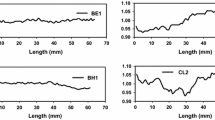Abstract
Displacement of oil trapped in water-wet reservoirs was analyzed using percolation theory. The critical capillary number of the CDC (Capillary Desaturation Curve) was be predicted based on the pore structure of the medium. The mobilization and stability theories proposed by Stegemeier were used to correlate oil cluster length to the capillary number needed to mobilize the trapped oil. Under the assumption that all pore chambers have the same size, a procedure was developed using the drainage capillary pressure curve and effective accessibility function to predict the CDC curve for a given medium. The prediction of critical capillary numbers was compared with the experimental data from 32 sandstone samples by Chatzis and Morrow. Also, the CDC curve of one sandstone sample was calculated using the procedure developed in this work and compared with the measured data. Very good agreements were obtained.
Similar content being viewed by others
Abbreviations
- a :
-
average radius of a liquid filament [m]
- c :
-
constant
- D :
-
pore throat diameter [m]
- D a :
-
advancing diameter of an oil cluster [m]
- D af :
-
average flowing diameter of the medium [m]
- D da :
-
controlling diameter of the medium [m]
- D r :
-
receding diameter of an oil cluster [m]
- D X :
-
difficulty index
- f :
-
ratio of length to average radius of an oil cluster
- F i :
-
interfacial forces [N]
- F p :
-
force from pressure gradient [N]
- g :
-
wettability function
- k :
-
absolute permeability [m2]
- l :
-
length of an oil cluster [m]
- l m :
-
mobile oil cluster length [m]
- l s :
-
stable oil cluster length [m]
- l w :
-
wavelength [m]
- n*:
-
relative length of an oil cluster
- N c 1:
-
capillary number defined by Equation (1)
- N c 2:
-
capillary number defined by Equation (2)
- P b :
-
probability of oil filling a pore
- P c :
-
percolation threshold value
- p c :
-
capillary pressure [N/m2]
- r :
-
radius of a pore [m]
- r e :
-
average pore radius [m]
- S n :
-
the nonwetting phase saturation
- S or :
-
residual oil saturation
- S orn :
-
normalized oil saturation
- v :
-
Darcy flow rate [m/s]
- X t :
-
total fraction of pores
- X a t :
-
accessibility
- X a e :
-
effective accessibility
- α(D):
-
pore throat size distribution function
- θ a :
-
advancing contact angle
- θ r :
-
receding contact angle
- Φ :
-
porosity
- ρ :
-
density of the liquid [kg/m3]
- λ :
-
constant in Equation (4)
- λ :
-
dynamic length of an oil cluster [m]
- σ :
-
interfacial tension [N/m]
- Μ :
-
viscosity [N/(m s)]
- ∇p :
-
pressure gradient [N/m3]
References
Anderson, W. G., 1987: Wettability literature survey — Part 6: The effects of wettability on waterflooding,J. Petrol. Technol. 39, 1283–1298.
Arriola, A., Willhite, G. P., and Green, D. W., 1983: Trapping of oil drops in noncircular pore throat and mobilization upon contact with a surfactant,Soc. Petrol. Eng. J. 23, 99–114.
Chatzis, I., and Morrow, N. R., 1984: Correlation of capillary number relationships for sandstone,Soc. Petrol. Eng. J. 24, 555–562.
Dullien, F. A. L. and Dhawan, G. K., 1973: Photomicrographic size distribution determination of non-spherical objects,Powder Technol. 7, 305–313.
Dullien, F. A. L. and Dhawan, G. K., 1974: Characterization of pore structure by a combination of quantitative photomicrography and Mercury porosimetry,J. Colloid Interface Sci. 42(2), 337–349.
Dullien, F. A. L., Dhawan, G. K., Gurak, N., and Babjak, L., 1972: A relationship between pore structure and residual oil saturation in tertiary oil recovery in a water-wet system,Soc. Petrol. Eng. J. 12, 289–296.
Lake, W. L., 1989:Enhanced Oil Recovery, Prentice-Hall, Englewood Cliffs.
Larson, R. G., Davis, H. T., and Scriven, L. E., 1981a: Displacement of residual nonwetting phase from porous media,Chem. Eng. Sci. 36, 75–85.
Larson, R. G. and Morrow, N. R., 1981b: Effects of sample size on capillary pressure in porous media,Powder Technol. 30, 123–138.
Larson, R. G., Scriven, L. E., and Davis, H. T., 1981b: Percolation theory of two phase flow in porous media,Chem. Eng. Sci. 36, 57–73.
Maconald, I. F. and Dullien, F. A. L., 1976: Correlating tertiary oil recovery in water-wet system,Soc. Petrol. Eng. J. 16, 7–9.
Mishra, B. K. and Sharma, M. M., 1988: Measurement of pore size distributions from capillary pressure curves,AIChE. J. 34, 684–687.
Ng, K. M., Davis, H. T., and Scriven, L. E., 1978: Visualization of blob mechanics in flow through porous media,Chem. Eng. Sci. 33, 1009–1017.
Oh, S. G. and Slattery, J. C., 1979: Interfacial tension required for Significant displacement of residual oil,Soc. Petrol. Eng. J. 19, 83–97.
Stegemeier, G. L., 1979: Mechanisms of entrapment and mobilization of oil in porous media, inImproved Oil Recovery by Surfactant and Polymer Flooding, Academic Press, New York.
Stegemeier, G. L., 1974: Relationship of trapped oil saturation to petro-physical properties of porous media, presented at the Improved Oil Recovery Symposium of Society of Petroleum Engineering ofAIME. Tulsa, OK.
Zhou, D., 1990: Invasion percolation and its applications in simulations of multiphase flow in porous media, PhD dissertation, Dept. of Chem. Eng., Technical University of Denmark.
Zhou, D. and Stenby, E. H., 1993: Interpretation of capillary pressure curves using invasion percolation theory,Transport in Porous Media 11, 17–31.
Author information
Authors and Affiliations
Rights and permissions
About this article
Cite this article
Zhou, D., Stenby, E.H. Displacement of trapped oil from water-wet reservoir rock. Transp Porous Med 11, 1–16 (1993). https://doi.org/10.1007/BF00614631
Received:
Revised:
Issue Date:
DOI: https://doi.org/10.1007/BF00614631




